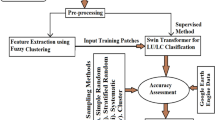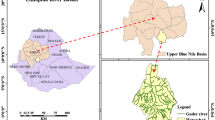Abstract
In this paper we present a method for correcting inherent classification bias in historical survey maps with which subsequent land cover change analysis can be improved. We linked generalized linear modelling techniques for spatial uncertainty prediction to fuzzy set based operations. The predicted uncertainty information was used to compute fuzzy memberships of forest and non-forest classes at each location. These memberships were used to reclassify the original map based on decision rules, which take into consideration the differences in identification likelihood during the historical mapping. Since the forest area was underestimated in the original mapping, the process allows to correct this bias by favouring forest, especially where uncertainty was high. The analyses were performed in a cross-wise manner between two study areas in order to examine whether the bias correction algorithm would still hold in an independent test area. Our approach resulted in a significant improvement of the original map as indicated by an increase of the Normalized Mutual Information from 0.26 and 0.36 to 0.38 and 0.45 for the cross-wise test against reference maps in Pontresina and St. Moritz, respectively. Consequently subsequent land cover change assessments could be considerably improved by reducing the deviations from a reference change by almost 50 percent. We concluded that the use of logistic regression techniques for uncertainty modelling based on topographic gradients and fuzzy set operations are useful tools for predictively reducing uncertainty in maps and land cover change models. The procedure allows to get more reliable area estimates of crisp classes and it improves the computation of the fuzzy areas of classes. The approach has limitations when the original map shows high initial accuracy.
Similar content being viewed by others
References
Ahlqvist O, Keukelaar J, Oukbir K (2003) Rough and fuzzy geographical data integration. Int J Geograph Inform Sci 17(3):223–234
Andréfouët S, Roux L, Chancerelle Y, Bonneville A (2000) A fuzzy-possibilistic scheme of study for objects with indeterminate boundaries: Application to French Polynesian reefscapes. IEEE Trans Geosci Remote Sensing 38(1):257–270
Baker WL (1989) A review of models in landscape change. Landscape Ecol 2(2):111–133
Bezdek JC (1981) Pattern recognition with fuzzy objective function algorithms. Plenum Press, New York
Binaghi E, Brivio PA, Ghezzi P, Rampini A (1999) A fuzzy set-based accuracy assessment of soft classification. Pattern Recognition Lett 20:935–948
Bolliger J, Mladenoff DJ (2005) Quantifying spatial classification uncertainties of the historical Wisconsin landscape (USA). Ecography 28:141–156
Brown DG (1998) Classification and boundary vagueness in mapping pre-settlement forest types. Int J Geograph Inform Sci 12(2):105–129
Burrough PA (1989) Fuzzy mathematical methods for soil survey and land evaluation. J Soil Sci 40:477–492
Burrough P, McDonnell R (1998) Principles of geographical information systems. Oxford University Press
Cheng T, Molenaar M, Lin H (2001) Formalizing fuzzy objects from uncertain classification results. Int J Geograph Inform Sci 15(1):27–42
Cohen J (1960) A coefficient of agreement for nominal scales. Edu Psychol Measurement 20:37–46
Coppin P, Jonckheere I, Nackaerts K, Muys B (2004) Digital change detection methods in ecosystem monitoring: a review. Int J Remote Sensing 25(9):1565–1596
Dubois D, Prade H (2000) Fundamentals of fuzzy sets. The handbook of fuzzy sets series. Kluwer Academic, Dordrecht, The Netherlands
Fisher P (2000) Sorites paradox and Vague Geographies. Fuzzy Sets Systems 113(1):7–18
Fonte CC, Lodwick WA (2004) Areas of fuzzy geographical entities. Int J Geograph Inform Sci 18(2):127–150
Foody GM (1996) Approaches for the production and evaluation of fuzzy land cover classifications from remotely-sensed data. International Journal of Remote Sensing 17(7):1317–1340
Forbes AD (1995) Classification algorithm evaluation: five performance measures based on confusion matrices. J Clin Monitoring 11:189–206
Gopal S, Woodcock C (1994) Theory and methods for accuracy assessment of thematic maps using fuzzy sets. Photogrammetric Eng Remote Sensing 60 (2):181–188
Guisan A, Zimmermann NE (2000) Predictive habitat distribution models in ecology. Ecol Modelling 135:147–186
Insightful (2001) S-Plus 6 for Windows: User’s Guide. Seattle7 Insightful, 688 pp
Jäger G, Benz U (2000) Measures of classification accuracy based on fuzzy similarity. IEEE Trans GeoSci Remote Sensing 38:1462–1467
Kienast F (1993) Analysis of historic landscape patterns with a Geographical Information system – a methodological outline. Landscape Ecol 8(2):103– 118
Klir GJ, Wierman MJ (1999) Uncertainty – based information – elements of generalized information theory. Springer, Physica-Verlag
Krishnapuram R, Keller JM (1993) A possibilistic approach to clustering. IEEE Trans Fuzzy Syst 1:98–110
Lewis HG, Brown M (2001) A generalised confusion matrix for assessing area estimates from remotely sensed data. Int J Remote Sensing 22(16):3223–3235
Leyk S, Boesch R, Weibel R (2005) A conceptual framework for uncertainty investigation in map-based land cover change modelling. Trans GIS 9(3):291–322
Leyk S, Zimmermann NE (2004) A predictive uncertainty model for field-based survey maps using Generalized Linear Models. In: Egenhofer M, Freksa C, Miller H (eds) GIScience 2004. Lecture Notes in Computer Science 3234. Springer, pp 191–205
Lu D, Mausel P, Brondizio E, Moran E (2004) Change detection techniques. Int J Remote Sensing 25(12):2365–2407
Matsakis P, Andréfouët S, Capolsini P (2000) Evaluation of fuzzy partitions. Remote Sensing Environ 74:516–533
Plewe B (2002) The nature of uncertainty in historical geographic information. Trans GIS 6(4):431–456
Power C, Simms A, White R (2001) Hierarchical fuzzy pattern matching for the regional comparison of land use maps. Int J Geograph Information Sci 15(1):77–100
Robinson VB (1988) Some implications of fuzzy set theory applied to geographic databases. Computers, Environ Urban Systems 12:89–97
Robinson VB (2003) A perspective on the fundamentals of fuzzy sets and their use in Geographical Information Systems. Trans GIS 7(1):3–30
Ruspini EH (1969) A new approach to clustering. Information Control 15:22–23
Steele BM, Winne JC, Redmond RL (1998) Estimation and mapping of misclassification probabilities for thematic land cover maps. Remote Sensing Environ 66:192–202
Woodcock CE, Gopal S (2000) Fuzzy set theory and thematic maps: accuracy assessment and area estimation. Int J Geograph Information Sci 14:153–172
Zadeh LA (1965) Fuzzy sets. Information Control 8:338–53
Acknowledgements
This study is part of the project “Retrospective Assessments“ funded by the Swiss Agency for the Environment, Forests and Landscape and the Swiss Federal Research Institute for Forest, Snow, and Landscape. We would also like to thank the two reviewers for their valuable comments.
Author information
Authors and Affiliations
Corresponding author
Rights and permissions
About this article
Cite this article
Leyk, S., Zimmermann, N.E. Improving land change detection based on uncertain survey maps using fuzzy sets. Landscape Ecol 22, 257–272 (2007). https://doi.org/10.1007/s10980-006-9021-2
Received:
Accepted:
Published:
Issue Date:
DOI: https://doi.org/10.1007/s10980-006-9021-2




